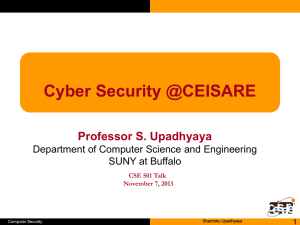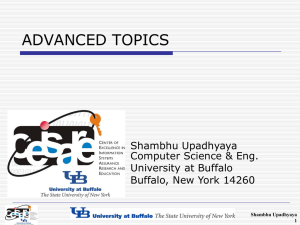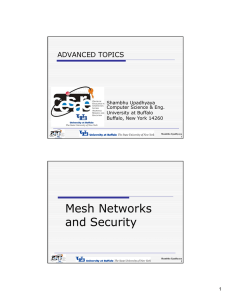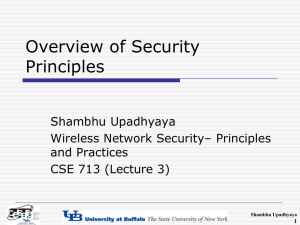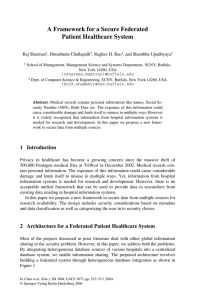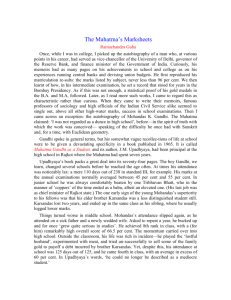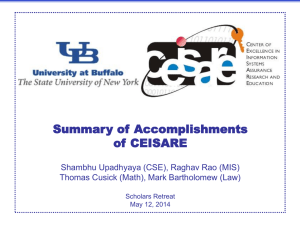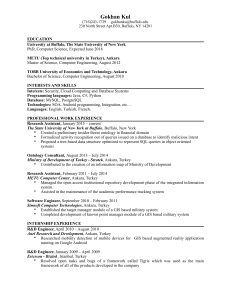Cyber Security: Challenges for th F t the Future Prof. Shambhu Upadhyaya
advertisement
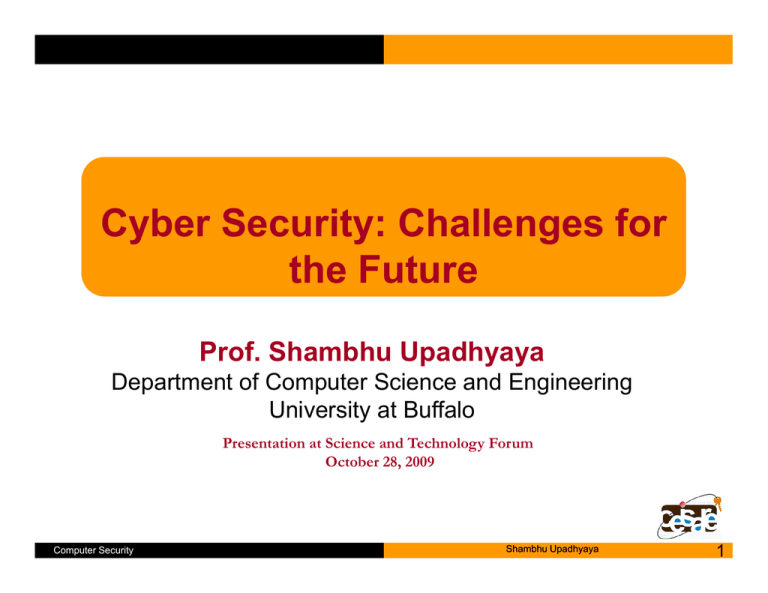
Cyber Security: Challenges for
th Future
the
F t
Prof. Shambhu Upadhyaya
Department of Computer Science and Engineering
University at Buffalo
Presentation at Science and Technology Forum
October 28, 2009
Computer Security
Shambhu Upadhyaya
1
Ou e
Outline
•
•
•
•
•
•
•
•
Acknowledgments
Cyber Security, Current Status
Challenges
g for the Future
A Cyber Security Primer
What are we doing at UB?
Selected Research Projects
Path Forward
Video Presentations
Computer Security
Shambhu Upadhyaya
2
A Famous
a ous Quote
Quo e o
on Secu
Security
y
• “If you think technology can solve your security
problems,
bl
then
th you don't
d 't understand
d t d the
th
problems and you don't understand the
t h l
technology”
”
Bruce Schneier, computer security specialist
• “Security
“S
it iis only
l as strong
t
as th
the weakest
k t lilink”
k”
Computer Security
Shambhu Upadhyaya
3
Pop
op Qu
Quiz !
• What is the most insecure place on earth?
– Answer:
A
Internet
I t
t
• What is the most heavily used network-based
application on the Internet?
– Answer: email
• Who are the most famous hackers of all time?
– Answer: Jonathan James,, Adrian Lamo,, Kevin
Mitnick
• Who is the father of modern cryptography?
– Claude Shannon, the information theorist
Computer Security
Shambhu Upadhyaya
4
Acknowledgments
c o edg e s
• Graduate students
–
–
–
–
–
–
Sunu Mathew (Ph
(Ph.D.)
D)
Duc Ha (Ph.D.)
Madhu Chandrasekaran (Ph.D.)
Mohit Virendra (Ph.D.)
S. Vidyaraman (Ph.D.)
Chris Crawford (MS)
( )
• Colleagues
– Prof. Hung Ngo
– Dr. Kevin Kwiat
• Funding agencies
– NSA,
NSA NSF,
NSF DARPA
• Google Images
Computer Security
Shambhu Upadhyaya
5
Ou e
Outline
•
•
•
•
•
•
•
Acknowledgments
Cyber Security, Current Status
Challenges
g for the Future
A Cyber Security Primer
What are we doing at UB?
Selected Research Projects
Path Forward
Computer Security
Shambhu Upadhyaya
6
Computer
Co
pu e Secu
Security
y Incident
c de 1
Computer Security
Shambhu Upadhyaya
7
New
e York
o Times,
es, Ja
January
ua y 22,, 2009
009
• A new digital plague (Conficker) has hit the
I t
Internet,
t infecting
i f ti millions
illi
off personall and
d
business computers in what seems to be the
fi t step
first
t off a multistage
lti t
attack.
tt k The
Th world’s
ld’
leading computer security experts do not yet
k
know
who
h programmed
d th
the iinfection,
f ti
or what
h t
the next stage will be
• Supposed to have unleashed massive attack
on April 1, 2009 – turned out to be a hoax!
• Could mean a digital “Pearl Harbor”
Computer Security
Shambhu Upadhyaya
8
Computer
Co
pu e Secu
Security
y Incident
c de 2
Computer Security
Shambhu Upadhyaya
9
Wall
a S
Street
ee Jou
Journal,
a , April
p 21,, 2009
009
• Computer Spies Breach Pentagons’s FighterJ t Project
Jet
P j t
• Hackers broke into DoD computers and
downloaded terabytes of data containing
design information about the Joint Strike
Fighter, a $300 billion stealth fighter currently
under development
Computer Security
Shambhu Upadhyaya
10
Computer
Co
pu e Secu
Security
y Incident
c de 3
Computer Security
Shambhu Upadhyaya
11
Wall
a S
Street
ee Jou
Journal,
a , April
p 8, 2009
009
• Electricity
y Grid in U.S. Penetrated By
y Spies
p
• Cyberspies have penetrated the U.S. electrical
grid and left behind software programs that
could be used to disrupt the system, according
to current and former national-security
national security officials
Computer Security
Shambhu Upadhyaya
12
Computer
Co
pu e Secu
Security
y Incident
c de 4
•
Aldrich Ames (Notorious Insider), a former CIA counterintelligence officer and analyst, sold-out his
colleagues to the Russians for more than $4.6 million, was convicted of spying for the Soviet Union and
Russia in 1994
•
•
R b tH
Robert
Hanssen (N
(Notorious
t i
IInsider),
id ) C
Caught
ht selling
lli A
American
i
secrets
t tto M
Moscow ffor $1
$1.4
4 million
illi iin cash
h
and diamonds over a 15-year period, Sentenced for life in prison without the ability for parole in 2002, Photo
Courtesy: USA Today
Have you watched the movie – Breach?
•
Try this link: http://www.rottentomatoes.com/dor/objects/868028/breach/videos/breach_020507.html
http://www rottentomatoes com/dor/objects/868028/breach/videos/breach 020507 html
Computer Security
Shambhu Upadhyaya
13
Security
Secu
y Breach
eac Reports
epo s
• CERT Coordination Center
– Located at CMU’s Software Engineering Institute
• US-CERT
– U.S. Computer Emergency Readiness Team
• NY State Cyber
y
Securityy and Critical
Infrastructure Coordination (CSCIC)
• SANS IInstitute
tit t Storm
St
Center
C t
Computer Security
Shambhu Upadhyaya
14
Types
ypes o
of Attacks
ac s
• Threats to national security
• Cognitive hacking
– Manipulating user’s perception
– “Killing” of Britney Spears (Oct. 2001)
• Worm attacks
– Sasser Worm (May 2004)
• Virus attacks
– SoBig.F (Aug. 2003), > $50M damage
– NIMDA virus in Sept. 2001
• DoS attacks
– Yahoo, Amazon, eBay, CNN (Feb. 2000)
• SQL injection attacks
– UN Website defacing (8/12/07)
Computer Security
Shambhu Upadhyaya
15
Web
eb News
e s ((Real?)
ea )
Computer Security
Shambhu Upadhyaya
16
Cognitive
Cog
e Hacking
ac g
• On Oct. 7, 2001, CNN’s top-ranked news story
• Example of a cognitive hacking where you manipulate a user’s
user s
perception
• These attacks are “hoax” like hoax Virus notifications
• Refer to: IEEE Computer, August 2002 issue:
– http://www.computer.org/portal/web/csdl/doi/10.1109/MC.2
002 1023788
002.1023788
• It began with a spoof of CNN.com
• Through a bug in CNN
CNN’s
s software,
software the article got spread when
clicked on “email this article”
• Within 12 hours, more than 150,000 people viewed the
spoofed page
Computer Security
Shambhu Upadhyaya
17
Phishing
s g Attacks
ac s
Computer Security
Shambhu Upadhyaya
18
Worst Securityy Mistakes End Users Make
• Failing to install anti-virus, keep its signatures
up-to-date,
t d t and
d apply
l it tto allll fil
files
• Opening unsolicited e-mail attachments
without verifying their source
• Failing
g to install security
yp
patches on favorite
applications
• Not making backups
• Using weak passwords
Computer Security
Shambhu Upadhyaya
19
Ou e
Outline
•
•
•
•
•
•
•
Acknowledgments
Cyber Security, Current Status
Challenges
g for the Future
A Cyber Security Primer
What are we doing at UB?
Selected Research Projects
Path Forward
Computer Security
Shambhu Upadhyaya
20
CSI/FBI
CS
/
Su
Survey
ey
• Annually, the CSI and the FBI release their
fi di
findings
on th
the survey
• Aims to raise level of security awareness
among businesses, educational and medical
institutions, and governmental agencies
• Goal to ascertain the type and range of
p
crime in the U.S. and to compare
p
computer
annual cybercrime trends with those of
previous yyears
p
Computer Security
Shambhu Upadhyaya
21
CSI/FBI
CS
/
Su
Survey
ey 2006
006
• 2006 survey
– Responses
R
off 616 computer
t security
it practitioners
titi
in U.S. corporations, government agencies,
financial institutions,, medical institutions and
universities
• The long term trends considered include:
– Unauthorized use of computer systems
– The number of incidents from outside as well as
inside an organization
– Types of attacks or misuse detected, and
– Actions
A ti
ttaken
k in
i response tto computer
t intrusions
i t i
Computer Security
Shambhu Upadhyaya
22
Major
ajo Findings
d gs
• Virus attacks continue to be the source of the
greatest financial losses
• Unauthorized use of computer systems slightly
decreased this year
• Use of cyber insurance remains low, but may
be on the rise
• The percentage of organizations reporting
computer intrusions to law enforcement has
reversed its multi-year decline
• Over 80% of the organizations conduct
security audits
Computer Security
Shambhu Upadhyaya
23
CSI/FBI
CS
/
Su
Survey
ey 2007
00
• 2007 survey
– Average cyber-losses jumping after 5-year decline
– Average annual loss $168,000 to $350,424 in this
year's survey
– Financial fraud overtook virus attacks as the source of
the greatest financial loss
• Additional key findings:
– 1/5th of respondents said they suffered a targeted
attack
– Insider
I id abuse
b
off network
t
k access or e-mailil edged
d d outt
virus incidents as the most prevalent security problem
Computer Security
Shambhu Upadhyaya
24
CSI/FBI
CS
/
Su
Survey
ey 2008
008
• The most expensive computer security incidents
were those involving financial fraud
fraud…
• Virus incidents occurred most frequently…
• Almost one in ten organizations reported they’d had a
Domain Name System incident…
• Twenty-seven
Twenty seven percent of those responding to a
question regarding “targeted attacks”…
• The vast majority of respondents said their
organizations either had (68%) or were developing
((18%)) a formal information securityy p
policy
y
Computer Security
Shambhu Upadhyaya
25
Cyber
y
Securityy Challenges
g
•
•
•
•
•
•
•
•
•
•
•
Data protection (e.g., data classification, identification and encryption)
and application software (e.g., Web application, VoIP) vulnerability,
sec rit
security
Policy and regulatory compliance (Sarbanes–Oxley, HIPAA)
Identity theft and leakage of private information (e.g., proprietary
information, intellectual property and business secrets)
Viruses and worms
Management involvement, risk management, or supportive resources
(human resources, capital budgeting and expenditures)
Access control (e.g., passwords)
User education, training and awareness
Wireless infrastructure security
Internal network security (e
(e.g.,
g insider threat)
Spyware
Social engineering (e.g., phishing, pharming) – steal identify
Computer Security
Shambhu Upadhyaya
26
The
e I3P
3 Report
epo (o
(on C
Challenges)
a e ges)
• Institute for Information Infrastructure Protection
formed a committee to address security R&D
challenges
– Senators Joe Lieberman and Susan Collins
• 4 emerging issues
– A coordinated and collaborative approach is needed
– Metrics for security are a broad enabler and must be
developed
– An effective legal and policy framework for security must be
created
– The human dimension of security must be addressed
•
http://www.thei3p.org/docs/publications/i3pnationalcybersecurity.pdf
Computer Security
Shambhu Upadhyaya
27
Other
O
e Key
ey Documents
ocu e s
• The National Strategy to Secure Cyber Space,
Februray 2003 (76 pages)
– Cyberspace touches practically everything and everyone
– Leadership from the top
– http://www.dhs.gov/xlibrary/assets/National_Cyberspace_S
trategy.pdf
• Cyber Space Policy Review (76 pages)
– President Obama presented the Cyberspace Policy
Review on May 29, 2009
– Beginning of the way forward towards a reliable, resilient,
trustworthy digital infrastructure for the future
Computer Security
Shambhu Upadhyaya
28
Ou e
Outline
•
•
•
•
•
•
•
Acknowledgments
Cyber Security, Current Status
Challenges
g for the Future
A Cyber Security Primer
What are we doing at UB?
Selected Research Projects
Path Forward
Computer Security
Shambhu Upadhyaya
29
What is Cyber
y
Security?
y
• Encryption/decryption
– Symmetric Key and Asymmetric Key Cryptography
• Authentication
– Kerberos
• Program
P
S
Security
it
– Virus, Trojan horse, Malicious code, Covert channels
• Network Security
– Firewall, Tripwires
– Electronic mail security, IP security, Web security
• Intrusion Detection
– Audit trail-based, Concurrent intrusion detection
Computer Security
Shambhu Upadhyaya
30
Securityy Goals
• Confidentiality
– Assets are accessible only to authorized parties
(privacy)
• Integrity
– Modification only by authorized parties so that
accuracy can be maintained
• Availability
– Assets accessible to authorized parties always
– No denial of service
– Timely response,
response Fair allocation,
allocation Fault tolerance
Computer Security
Shambhu Upadhyaya
31
People
p Involved – The Bad Guys
y
• Ordinary people, teenagers or college students
• Amateurs
– Most of the crime committed by amateurs
– They observe a flaw in security and take advantage of
– There are so many tools publicly available
• Crackers
– University or high school students
– Done for no good reason, maybe some kind of selfsatisfaction
– This continues to be an appealing crime, to juveniles
• Career Criminals
– Do for personal gain, spying
Computer Security
Shambhu Upadhyaya
32
Methods of Defense
• Encryption
– Coding
– No encryption is perfect -- weak encryption
can actually
t ll b
be worse!!
• Software Controls
– Internal, OS level or Developmental level
• Filters
– Firewalls
Computer Security
Shambhu Upadhyaya
33
Cryptography
yp g p y Basics
• Encryption
– A process of encoding a message
• Decryption
– It is the reverse process
Plaintext
Ciphertext
Encryption
P=(p1,p2, …pn)
Original
Plaintext
Decryption
( , , … cm))
C=(c1,c2,
C=E(P)
P=D(C)
=D(E(P))
• Encryption Algorithms
– A key K is generally used
– Symmetric encryption: P = D ( K , E ( K , P ))
– Asymmetric encryption: P = D( KD, E( KE, P))
Computer Security
Shambhu Upadhyaya
34
Symmetric
Sy
e c Key
ey Encryption
c yp o
• Data Encryption Standard (DES)
– Most widely
idel used
sed block cipher in the world,
orld adopted in 1977
by NBS (now NIST)
– Encrypts
yp 64-bit data using
g 56-bit keyy
– Had widespread use until early 2000
– Has been subject to considerable controversy over its
security
• Advance Encryption Standard (AES)
– 128-bit data, 128/192/256-bit
/
/
keys
– Stronger & faster than Triple-DES
– Active life of 20
20-30
30 years (+ archival use)
Computer Security
Shambhu Upadhyaya
35
Asymmetric
sy
e c Key
ey Encryption
c yp o ((PKI))
• Perhaps the only true revolution in the history
off cryptography
t
h
• Based on mathematical functions unlike
conventional ones
• DES is a significant
g
advance by
y IBM,, but
based on substitution and permutation
• PKEs are asymmetric techniques -- use two
separate keys
• Enhance confidentiality
confidentiality, key distribution and
authentication
Computer Security
Shambhu Upadhyaya
36
PKI Illustration
us a o
(Courtesy: William Stallings)
Computer Security
Shambhu Upadhyaya
37
Ou e
Outline
•
•
•
•
•
•
•
Acknowledgments
Cyber Security, Current Status
Challenges
g for the Future
A Cyber Security Primer
What are we doing at UB?
Selected Research Projects
Path Forward
Computer Security
Shambhu Upadhyaya
38
Computer
Co
pu e Sc
Science
e ce a
and
d Engineering
g ee g
• 25 faculty members, world class researchers
• Ranked
R k d 21stt in
i the
h nation
i iin research
h ffunding
di
• 350 UGs and 220 Grad students
Current Building
Computer Security
Future Building
Shambhu Upadhyaya
39
CEISARE
• CEISARE designated as a National Center
y NSA,, DHS
of Excellence in 2002 by
– Through a competitive process
– We were one of 13 centers designated that
year (36 across the country)
– Today,
y, there are 100+ centers
– Based on curriculum mapping to CNSS
((committee of National Security
y Standards))
4011, 4013, research, infrastructure, etc.
Computer Security
Shambhu Upadhyaya
40
CEISARE
Computer Science &
Engineering
Law School
School of Management
LAW
CSE
SOM
Center for Unified Biometrics
and Sensors
CEISARE
Information Systems
Assurance Research
and Education
MAT
CUBS
Mathematics
Information
Assurance
ILPB
Lasers, Photonics &
Bi h t i
Biophotonics
CCR
Bioinformatics
Computer Security
Computational Research
Shambhu Upadhyaya
41
IA Facultyy Collaborators
Biometrics
Govindaraju,
Cartwright
Wireless,
Mobile
Upadhyaya,
U
dh
Zhong, Sridhar
Computer Security
Trust,
E-commerce
E
commerce
Rao, Zhong
Intrusion
Detection
Upadhyaya, Ngo
Legal &
Ethical
Issues
Bartholomew
Language
Issues
Jayaraman,
Upadhyaya
Shambhu Upadhyaya
42
Research
esea c & O
Other
e Sy
Synergistic
e g s c Activities
c
es
•
Funding
– Over 4M from NSF, DARPA, NSA/ARDA, AFRL, DoD (since 2002)
– Research, education, infrastructure
•
Curriculum
– Cyber
y
security
y at Ph.D. level
– Advanced Certificate in IA
– IASP scholarships (DoD and NSF)
•
Workshops
– SKM 2004, SKM 2006, SKM 2008
– Local Joint IA Awareness Workshops with FBI, ECC, Local industries
•
Outreach Activities
– High school workshops
– Minority training
Computer Security
Shambhu Upadhyaya
43
Ou eac / a e s ps
Outreach/Partnerships
• Govt. Partners
– AFRL,, Rome (Research
(
Associate Professor))
– FBI Cyber Task Force (Infragard, workshop participation)
– Local government (advisory board membership)
• Industry
– HP, M&T Bank (advisory board)
– Intel Corporation
p
((security
y research sponsorship)
p
p)
• Academia
–
–
–
–
–
Hilbert College (NSF Capacity building grant)
Erie Community College (NSF ATE grant)
Genesee Community College (NSF Capacity building)
Polytechnic
y
Universityy (CSAW
(
contest))
Purdue University (Forensics initiative)
Computer Security
Shambhu Upadhyaya
44
Graduate Certificate in IA
• Effort started with funds from DoD, 2003
– Funding
g was to create a new integrative
g
course in IA
• Two tracks – technical and managerial
q
• Requirements
– 6 credits of core courses in the track
– 5-6 credits of elective in the dept.
– 3 credits of required integrative course
• Technical track
– Core – Intro. to Crypto, Computer security, Wireless
networks security (choose two courses)
• Managerial
M
i l ttrack
k
– Core – Network management, E-Commerce security
Computer Security
Shambhu Upadhyaya
45
CEISARE Courses
•
•
Courses with IA Content
– CSE 565 Computer Security
– CSE 566 Wireless Networks Security
– CSE 512 A
Applied
li d C
Crypto
t and
dC
Computer
t S
Security
it
– CSE 671 Security in Wireless Ad Hoc and Sensor Networks
– LAW 629 Computers, Law, Technology and Society
– LAW 645 Copyright
– Law
La 956 E
E-Commerce
Commerce La
Law
– MGA 615 Fraud Examination
– MGS 650 Information Assurance
– MGS 651 Network Management
– MGS 659 E
E-Commerce
Commerce Security
– MGT 681 Intellectual Property
– MHI 512 Ethical, Social & Human Factors in Medical/Health Informatics
– MTH 529/530 Introduction to the Theory of Numbers I/II
– MTH 535 Introduction to Cryptography
– MTH 567 Stream Ciphers
Other Technical Electives
– http://www.cse.buffalo.edu/caeiae/advanced_certificate_program.htm
Computer Security
Shambhu Upadhyaya
46
Ou e
Outline
•
•
•
•
•
•
•
Acknowledgments
Cyber Security, Current Status
Challenges
g for the Future
A Cyber Security Primer
What are we doing at UB?
Selected Research Projects
Path Forward
Computer Security
Shambhu Upadhyaya
47
Research
esea c Projects
ojec s
• Most federally funded
• Some industry funded
• Disciplines
p
ranging
g g from Networks Security
y to
Wireless Networks Security
Computer Security
Shambhu Upadhyaya
48
Real-Time Intrusion Detection with Emphasis on
I id Att
Insider
Attacks
k (2003 - 07)
•
•
•
A novel security system based on the encapsulation of owner's intent
C be
Can
b readily
dil used
d as a concise
i reference
f
for
f monitoring
it i off intrusions
i t i
How – By actively querying the user for his intent
– Build a small and manageable set of assertions
– Leads to search space that is more focused
– System is able to respond faster, make fewer mistakes and scale well
•
•
Moving away from the traditional method of detecting intrusions through
low level network and other resource audit, to a much higher level
Net gain – Capture semantic perspective of what the user wants to
accomplish
Computer Security
Shambhu Upadhyaya
49
Impact
pac
• Graduate Students
– R.
R Chinchani (Ph
(Ph.D.,
D May 2005)
– A. Muthukrishnan (M.S., June 2004)
– M. Chandrasekaran ((M.S.,, June 2004))
• Publications
• IWIA 2003, ACSAC 2004, Book Chapter on Managing Cyber
Threats, Springer 2005
• Funding Agency: DARPA (2003-05), AFRL (2000-06)
• Media
– Washington Post, NY Times, CBS, NewScientist, Scientific
American,, etc.
Computer Security
Shambhu Upadhyaya
50
Event Correlation for Cyber Attack Recognition System (ECCARS)
S. Upadhyaya (CSE), Moises Sudit (IE), W. Tagliaferri (Alion Science), NSA/ARDA (9/03 – 12/05)
Goals
Other Internal Data
•
- Current Threat Level
Collect, store and process large amounts of data
– Cyber sensor observables
– Real world events
Fuse the resultant network data into meaningful threat
related events
Perform analysis to find correlations between cyber
sensor data and real world events and trends
Present the information to the analyst in a manner
he/she can rapidly make a decision regarding
defensive actions
Test a prototype with basic functionality
- QOS Policies
Data Fusion Engine
Network Management
- Observables
Intrusion Detection
- Observables
RealReal-World Events
•
- Observables
ct
ur
e
•
fo
rm
at
io
n
In
f
ra
st
ru
•
In
•
Novel Ideas
•
•
•
Correlation
C
l ti off di
disparate
t sources off iinformation,
f
ti
system
t
event information with real-world events, drawn from
various information sources using information extraction
techniques coupled with a 4-level information fusion
framework
Concept of sensor tasking through the use of mobile
sensors that can work in conjunction with the data fusion
processes for enhanced threat mitigation
OOD design with APIs enabling plug-n-play capability for
information extraction, fusion and visualization components
Computer Security
Accomplishments/Milestones
•
•
Prototype ready for testing with data from an experimental
testbed
Papers published:
–
Mathew S., C. Shah and S. Upadhyaya, “An Alert Fusion
Framework for Situation Awareness of Multistage
Coordinated Attacks”, IEEE International Workshop on
Information Assurance, Washington DC, March 2005.
–
Mathew S., D. Britt, R. Giomundo, S. Upadhyaya, M. Sudit
and A. Stotz, “Real-time Multistage Attack Awareness
Through Enhanced Intrusion Alert Clustering”, to be
presented
t d in
i SIMA 2005,
2005 Oct.
O t 2005.
2005
Shambhu Upadhyaya
51
Impact
pac
• Graduate Students
– S. Mathew (Ph.D. June 2009), C. Shah (M.S., Jan.
2005)
• Publications
– IEEE IWIA 2005, IEEE SIMA 2005, ACM VizSec
2006
• Funding Agency
– NSA/ARDA (2004-06), AFRL (2004-06)
• This work was taken into Phase 2 by
y CMIF
and Alion Science
Computer Security
Shambhu Upadhyaya
52
Multi-phase Approach for Preventing Document Abuse from Malicious Insiders
Shambhu Upadhyaya, Funded by NSA/ARDA, 2003-05
usr
1
doc
session
Dynamic
D
i P
Policies
li i
in effect
¾
Security policy
Forensics &
Tamper-proof
usr
n
Goals
learn
File
Repository
¾
¾
¾
Malicious and masquerading insider threat detection in
the Document Control domain
Identifyy importance
p
of documents
Identify user roles in organizations
Prevent circumvention and perform trace-back
historyy
search
Anomaly
Detector
Document
Classifier
Alerts?
Novel Ideas
•
•
•
•
•
Building user profiles at the application level
Usage based document classification
Context & information flow based policy specification for
preventing insider abuse
Automated generation of dynamic policies
Papers Published:
–
IEEE Information Assurance Workshop, West Point, NY,
June 2004
–
20th Annual Computer Security Applications Conference,
Tucson, AZ, December 2004
Computer Security
Accomplishments/Milestones
Prototype for Microsoft Word
Monitor and detect masqueraders based on
document usage
Specify and enforce dynamic policies
Prototype for dynamic policies generation
http://www cse buffalo edu/DRM
http://www.cse.buffalo.edu/DRM
Future Plans
Detecting the convergence of disparate role
structures in collaborating organizations
Preventing circumvention of the tools
Shambhu Upadhyaya
53
Impact
pac
• Graduate Students
– S. Pramanik (Ph.D., Aug. 2007), S. Vidyaraman
(Ph.D., Feb. 2008), N. Shah (M.S., June 2004), A.
Garg (Ph.D.,
(Ph D June 2006)
• Publications
– IEEE IA Symposium 2004, ACSAC 2004, IA
Symposium 2006, IEEE ICC 2006
• Funding Agency
– NSA/ARDA (2003-05)
Computer Security
Shambhu Upadhyaya
54
SWEDEN: A New Framework for Secure and Trusted Communications in Wireless Data
Networks, Shambhu Upadhyaya, Funded by AFRL, NSF/Cisco, 2004-09
Goals
SWEDEN
Framework
Pre-key
Establishment
Phase
Trust Framework:
Basis for Key
Management with
Unknown Nodes,
Clustering Decisions
Normal Network
Functioning Phase
Key and Traffic
Management
Schemes
Key Management and
Encryption Schemes
¾
Robustness Schemes
Post attack
Post-attack
Survivability and
Recovery Schemes
Secure and
Reliable Data
Delivery
¾
¾
¾
Design decision making framework for nodes to establish
keys with other unknown nodes
Use this framework for cluster forming
g decisions in ad-hoc
networks
Improve on existing key management schemes and design
secure data delivery schemes for enhanced reliability in
data transfer
P id schemes
Provide
h
ffor resiliency
ili
against
i t attacks
tt k and
d postt
failure recovery
Novel Ideas
•
•
•
•
•
Trustt between
T
b t
the
th nodes
d used
d as a metric
t i for
f decision
d i i
making
Differential encryption (header and payload differently)
scheme for ad-hoc networks, and hashing based
lightweight techniques for sensor networks
E l ti
Evaluating
security
it off paths
th and
d nodes
d based
b
d on their
th i
relative position in the network
Building in survivability in the network architecture
proactively for surviving potential attacks
Robustness, Recovery and Survivability Schemes
Computer Security
Accomplishments
Setting up of the NSF and Cisco sponsored
Wireless Security Lab
Representative Publications:
IEEE Conference on Local Computer Networks (LCN),
Tampa, FL, Nov 2004
g Park,, MD,, Mar 2005
IEEE ACM IWIA,, College
IEEE Conference on Knowledge Intensive Multi-agent
Systems (KIMAS), Boston, MA, Apr 2005
Secure Knowledge Management (SKM), Sep 2004
MMM 2007, St. Petersburg, 2007
Future Plans
Security Schemes for mesh networks
Performing hands-on experiments at the Wireless Security
Lab
Shambhu Upadhyaya
55
Impact
pac
• Graduate Students
– M. Virendra (Ph.D., June 2008), M. Jadliwala
(Sept. 2009), Ameya Sanzgiri (stated June 2009),
Chris Crawford (M.S.,
(M S June 2009)
• Publications
– KIMAS 2005, SKM 2006, IEEE ICC 2007, MMMACNS 2007, IEEE SRDS 2007, Infocom 2008,
WiSec 2009
• Funding Agency
– Air Force Research Laboratory (2007-09)
Computer Security
Shambhu Upadhyaya
56
Changing HCI Transparency Paradigms to Mitigate the Weak Human Factor in IT
Systems, Shambhu Upadhyaya, Funded by AFRL, 2000-08
Goals
¾ Mitigate the weak Human Factor in IT
Systems
¾ Classify Users as Cooperative, Non
Cooperative and Malicious
¾ Evaluate User Trust Levels
¾ Provide a technically meaningful process to
elicit user cooperation
Novel Ideas
•
•
•
•
Logging & Analyzing User Characteristics (TimeInvariant & Role based)
Changing QoS to elicit user cooperation
Quantifying Security State based on adherence to
best practices
Papers Published:
–
Accomplishments
Game-Theoretic Model for changing QoS
A HIDS Prototype on Windows
Dynamic Trust Assignment and Update
Mechanisms based on user actions
Sankaranarayanan V., M. Chandrasekaran and S. Upadhyaya,
“Towards Modeling Trust Based Decisions: A Game Theoretic
Approach”, 12th European Symposium on Research in Computer
Security (ESORICS 2007)
2007), Dresden
Dresden, Germany
Germany, Sept
Sept. 2007
Computer Security
Shambhu Upadhyaya
57
Impact
pac
• Graduate Students
– S. Vidyaraman (Ph.D., June 2008)
• Publications
– iTrust 2006, Ubisafe 2007, ESORICS 2007
• Funding
g Agency
g
y
– Air Force Research Laboratory (2004-08)
Computer Security
Shambhu Upadhyaya
58
Fundamental Approaches to Dealing with Malware on the Internet
Shambhu Upadhyaya, State University of New York at Buffalo, Funded by DoD, 2007-09
Objective
A unified behavior based framework for mitigating
threats and damaging attacks on the Internet
Address phishing, zero-day exploits, spyware, email
authorship attribution, information leak in documents
Hardware acceleration to support scalability
State of the art in the area
Malware on the Internet is rampant
Behavior-based defense used successfully in real-world
Extended to cyber-world by researchers at Columbia U.
Behavior capture and correlation of applications using
programming languages
Behavior based monitoring for attack detection using
statistical and rule-based algorithms
Behavior based techniques for network forensics using
causality graphs
Designing new hardware for content processing and
cryptography
Computer Security
The approach
B h i C
Behavior
Capture
t
and
dA
Analysis
l i (f
(feature
t
selection,
l ti
simulated annealing)
Behavior Based Monitoring and Detection (support
vector machines)
Attack Attribution and Forensics (causality graphs)
Attack-Agnostic Framework (component based
approach, implementing theories in hardware on
modern CPUs)
Validation (user studies)
Novel ideas
Attack-agnostic framework to address all facets of security
– attack protection, detection, response and forensics
A holistic approach
Proof-of-concept prototypes for anti-phishing, handling
zero-day exploits, malicious email attribution, anti-spyware,
information leak detection
Hardware acceleration techniques to handle “pump and
dump” malware
Grounded in theory and preliminary investigation
– "Spycon:
"Sp con Emulating
Em lating user
ser activities
acti ities to detect e
evasive
asi e
Spyware”, IEEE Malware 2007 (Best paper award)
Shambhu Upadhyaya
59
Impact
pac
• Graduate Students
– M. Chandrasekaran (Ph.D., June 2009), N. Pulera
(M.S., June 2008), H. Alkebulan, (M.S., Dec.
2008) N
2008),
N. Campbell (B
(B.S.,
S Dec
Dec. 2008)
• Publications
– Ubisafe 2006, Malware 2007 (Best Paper Award),
Albany IA Conference 2007, 2008
• Funding Agency
– DoD (2007-08)
Computer Security
Shambhu Upadhyaya
60
Accelerating Techniques for Rapid Mitigation of Phishing
and
dS
Spam E
Emails
il
•
•
•
•
Phishing scams pose a serious threat to end-users and commercial
institutions
Current software based solutions cannot be implemented on end-user's
local computers due to the computation overhead involved with the
associated feature selection and data mining algorithms
We aim at detecting phishing attacks based on the semantic and structural
properties present in the content of the phishing emails at the end-user
level
Our solution is hardware based
– We are implementing some basic theories such as Simulated Annealing,
ayes a Learning,
ea
g, a
and
d Associative
ssoc at e Rule
u e Mining
g in tthe
e hardware
ad ae
Bayesian
– Exploit the inbuilt pipelining, scheduling and other accelerator capabilities and
the micro engines of the Intel Tolapai processor
Computer Security
Shambhu Upadhyaya
61
Impact
pac
• Graduate Students
– M. Chandrasekaran (Ph.D., June 2009), Ajay
Nagrale (M.S., June 2010), Pranil Gupta (M.S.,
June 2010)
• Publications
– Intel Summit, Feb. 2009, ECSC 2009 (in
conjunction with IEEE SRDS 2009)
• Funding Agency
– Intel Corporation (2008-10)
Computer Security
Shambhu Upadhyaya
62
TECHNIQUES FOR RAPID
MITIGATION OF PHISHING
AND SPAM E
E-MAILS
MAILS
63
Computer Security
Shambhu Upadhyaya
63
INTRODUCTION
• E-mail is the most popular tool for exchanging
personall and
db
business
i
iinformation
f
ti
• Simple Mail Transfer Protocol (SMTP, RFC
5321; RFC 821) defines standard for sending
messages
• Drawbacks with SMTP protocol
– Authentication
– Integrity
– Non
Non-repudiation
repudiation
Computer Security
64
Shambhu Upadhyaya
64
AUTHENTICATION
Domain Keys,
y SPF, CSV, SenderID
DNS Records
Who is the sender?
Bob
Phisher
SMTP Server
Secure SMTP
Bob
From:Bob@example com
From:Bob@example.com
Alice
Digital Signatures
Phisher
Computer Security
65
PGP, GPG, Identity based encryption
Shambhu Upadhyaya
65
INTEGRITY
Is message changed in
transit?
PKI Encryption
Bob
Alice
Phisher
Computer Security
66
Shambhu Upadhyaya
66
NON REPUDIATION
NON-REPUDIATION
Can e-mail be linked to Bob so
that he cannot refute?
Digital Signatures/ PKI
Bob
Alice
67
Computer Security
Shambhu Upadhyaya
67
Drawbacks of Secure Email Tools
• Adoption is not straightforward
– Requires revamp of existing e-mail
e mail infrastructure
• Human factors Issues
– Users are bad in encrypting
encrypting, decrypting and signing
messages
• Suffers from key exchange problem
– Need for third-party CA or trusted platform
• Encryption/Decryption
/
off messages is not
supported by most Web-based clients
– Yahoo! and Gmail use DKIM, however still most 68
other services don’t
Computer Security
Shambhu Upadhyaya
68
Email Phishing Attacks
• Lack of authentication, integrity, repudiation =
Phishing attacks
• Victim is sent an email with links referring to
corresponding spoofed website
• Efficient coverage and ease of execution
• Preys upon user’s
user s inability to make correct decision
69
Computer Security
Shambhu Upadhyaya
69
Existing Filtering Techniques
• Browser add-ons and third-party toolbars
– Not scalable, black/white listing info. may not
reach clients in time
– Zhang et al. study shows poor performance
Arms Race
• Using spam filters
– 1-gram words, IP-based URL, different hidden
and visible links
• Content based filters
||
– Textual and structural features
• Phishing
g Website Analysis
y
– Domain validation, URL de-obfuscation, link
analysis and image analysis
• Suffer from false positive and false negative User takes the bait
70
rates
Computer Security
Shambhu Upadhyaya
70
Anatomy of Phishing E-mail
E mail
71
Computer Security
Shambhu Upadhyaya
71
Phishing – A Social Engineering Attack
• Uses threat, concern, reward to attract users
• Threat
– Provide password within 24 hours to avoid account
revocation
• Concern
– Your account has been compromised.
p
Please p
provide new
username and password
– Password insecure, provide strong one
• Reward
– Provide your details to get $10,000,000
– Nigerian
Ni i S
Scammers
Computer Security
72
Shambhu Upadhyaya
72
Features Used for Detection
• Three classes of features used
• Textual features (individual words)
– 1gram, 2gram, and 3gram words
– Normalized using stopword elimination and
stemming
• Linguistic features
– Grammatical statistics to indicate ratio of nouns,,
pronouns, verbs, and 10 more similar features
• Structural features
– Salutation, IP based URLs, difference in URLs
Computer Security
Shambhu Upadhyaya
73
73
Supervised ML Algorithms
• Features from e-mails are fed into supervised
machine
hi llearning
i algorithms
l ith
ffor classification
l
ifi ti
• Has two phases:
– Training phase – learns the classification model
– Testing phase – Uses the learned model to classify
incoming e
e-mails
mails into phishing and ham
• Three popular supervised machine learning
algorithms are used
– Naïve Bayesian Classifier
– Decision Trees
– Support Vector Machines (SVM)
Computer Security
74
Shambhu Upadhyaya
74
NAÏVE BAYESIAN CLASSIFIER
• Based on Bayes theorem and conditional independence
assumption
• Given a set of input features X = {x1, x2, …, xn} and class labels
C = {c1, c2, …, cn}, naïve Bayes classifier assigns X class label
such
h that
h
– Pr(ci | X) > Pr(cj | X), for all i ≠ j
• Bayes rule relates Pr(ci|X) to Pr (X|ci)
• Application of conditional independence, equation becomes
Prior probability obtained
f
from
training
t i i
75
Computer Security
Shambhu Upadhyaya
75
SUPPORT VECTOR MACHINES (SVM)
• Used in binary classification problem,
– C = {+, }, + Æ ham,
Æ phishing
• Input features are plotted in high dimensional
vector space
• Learns to build a separating
p
g hyperplane
yp p
h to
separate two classes
76
Computer Security
Shambhu Upadhyaya
76
DECISION TREES
• Builds decision trees with
class label along with leaves
• Non-leaf nodes represent
constraint on some input
feature
• Is viewed as series of if-else
tests
• ID3 algorithm is used to
construct decision trees
77
Computer Security
Shambhu Upadhyaya
77
Experimental Setup
• Dataset
– Phishing corpus – 4550 phishing e-mails
e mails obtained
over period of three years (2004 – 07)
– Ham dataset – 6950 e-mails
e mails from SpamAssassin
dataset
• Setup
– 10-fold cross folding is used (90% training, 10%
testing)
• Performance is measured using detection rate,
false positive rate
rate, precision
precision, recall
recall, f1 statistic78
Computer Security
Shambhu Upadhyaya
78
Results
>99% detection
rate & <0.3
false positive rate
using linguistic
features
79
Computer Security
Shambhu Upadhyaya
79
Limitations
• Building and deploying decision trees, SVM and naïve
Bayesian classifiers is computation
computation-intensive
intensive
• When spam load increases, solutions may prove to
be sluggish
• Should be deployed at MTA for better speed and
efficiency
• Has number of subcomponents that can be done in
parallel
– Different branches of decision trees can be traversed
independently
80
– Feature extraction, probability estimation and classification
in NB and SVM can be done in parallel
Computer Security
Shambhu Upadhyaya
80
Intel Tolapai Salient Features
• Gigabit Ethernet (GbE) Controller
– Highly integrated, high-performance Ethernet
LAN Device
– Implements hardware acceleration capabilities
– Offloads checksum capabilities from host
processor
– Filters p
packets based on checksum errors
– Minimizes I/O accesses and interrupts
– Supports various address filtering
81
Computer Security
Shambhu Upadhyaya
81
Tolapai Salient Features Contd.
• Acceleration of cryptographic operations
– Symmetric Operations:
• Cipher: AES, DES, 3DES, NULL, ARC4
• Hash/Authentication:
H h/A th ti ti
SHA,
SHA MD5
MD5, AES
• SSL/TLS Key Generation
– Public Key Operations
• Diffie-Hellman Key Generation
• RSA,
RSA DSA
• Primality Tests, Large Number Operations (Modular
Inversion & Modular Exponentiation)
82
– Random Number Generation
Computer Security
Shambhu Upadhyaya
82
Integrating with Tolapai
Controlling Custom Application
Intel Quick Assist Technology API
D t mining
Data
i i Modules
M d l
SVM
Bayesian
Apriori
Protoocol wrapperss
L level
Low
l l acceleration
l ti modules
d l
such as Packet Classify, Crypto
Modules
Deccision Engine
Paylooad Scanner/
Conteent Tokenizerr
Incoming
packets
Protoocol wrapperss
IA Acceleration Drivers
RISC Micro Engine
g Modules
Computer Security
Filtered
packets
83
Shambhu Upadhyaya
83
Setting Tolapai Board
• Installed CentOS 5.2 with Gcc 4.1 and Glibc 2.5
• Rebuilt
R b ilt K
Kernell ((applied
li d new RPM packages
k
&
patches)
• Prepared fresh Kernel 2.6.18EP805XX
• Installed all the Embedded & Cryptographic drivers
(sys. calls – setkey, encrypt_r, setkey_r)
• Enabled Crypto and other Debug tools
• Added Tolapai machine in LAN & started sendmail
and procmail to support Email flow
• Analyzed Cryptographic API & new system calls
• Hacked GbE code to understand packet processing
Computer Security
Shambhu Upadhyaya
84
Board Assembly (Courtesy: Intel)
85
Computer Security
Shambhu Upadhyaya
85
NB Algorithm
• Whether spam filtering or phishing detection, NB is used
as a text classifier
• Training phase and classification phase
• Training phase
– Parsing email
– Tokenizing
– Hash
H h maps – separate
t tables
t bl for
f spam and
d ham
h
emails
il and
da
third table for mapping probabilities to tokens
• Classification phase
– Essentially hash table lookup
• Acceleration in tokenizing and hash computation
– Hashing is moved to hardware using the APIs
Computer Security
Shambhu Upadhyaya
86
86
Results
87
Computer Security
Shambhu Upadhyaya
87
Summary
• Traditional SMTP protocol has security design flaws
• Phishers and spammers exploit them to pump-and-dump
pump and dump
spurious e-mails
• Spam detection approaches fail miserably
• Linguistic and structural features encapsulate phisher’s
intent and improve detection rate
• Software implementation of classifiers is computationally
expensive
• Work is p
preliminary
y ((only
y hash function implemented)
p
)
• Currently working on full implementation
88
Computer Security
Shambhu Upadhyaya
88
Ou e
Outline
•
•
•
•
•
•
•
Acknowledgments
Cyber Security, Current Status
Challenges
g for the Future
A Cyber Security Primer
What are we doing at UB?
Selected Research Projects
Path Forward
Computer Security
Shambhu Upadhyaya
89
Co c us o s
Conclusions
• “This is not the end. It is not even the
b i i off th
beginning
the end.
d B
Butt it iis, perhaps,
h
th
the
end of the beginning.”
Sir Winston Churchill
• We need to look forward
Computer Security
Shambhu Upadhyaya
90
Looking
g Forward
• CEISARE has been designated as CAE-R (2009-14)
• Aligning
g g with Cyber
y
Security
y Act of 2009 ((S.773)
– address our nation's vulnerabilities to cyber crime, global cyber
espionage, and cyber attacks
• We need to train cyber sleuths
– At UB, we graduated 6 scholars through DoD program
– In 2008, we received a $868,000 grant from NSF Federal Cyber
S i P
Service
Program
– We have 5 scholars, funds to educate 4 more in 2010-11
• "Cybersecurity
Cybersecurity is one of our most urgent priorities"
priorities says DHS
chief Janet Napolitano, Oct. 2, 2009
– DHS to hire up to 1,000 CS experts in 3 years
– House
H
panell plans
l
cyber
b security
i training
i i ffor members
b
and
d staff
ff ((cyber
b
flu shots – Oct. 27, Oct.30, 2009)
Computer Security
Shambhu Upadhyaya
91
Ques o s
Questions
• My contact: shambhu@buffalo.edu
• Center Website:
http://www.cse.buffalo.edu/caeiae
Computer Security
Shambhu Upadhyaya
92
Video
deo Presentation
ese a o
• Social Engineering Attack
– Interview with Kevin Mitnick (Courtesy: CBS 60
Minutes Segment) – 20 minutes
• Cyber Security Awareness
– NYS CSCIC (Courtesy: William Pelgrin, Director) –
25 minutes
Computer Security
Shambhu Upadhyaya
93
